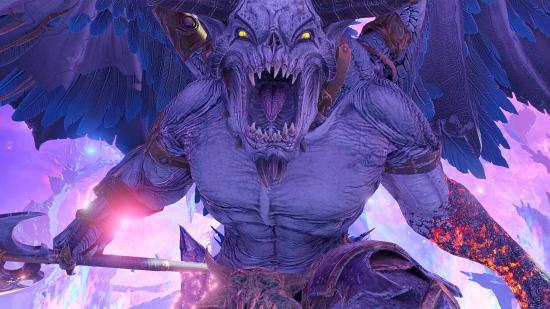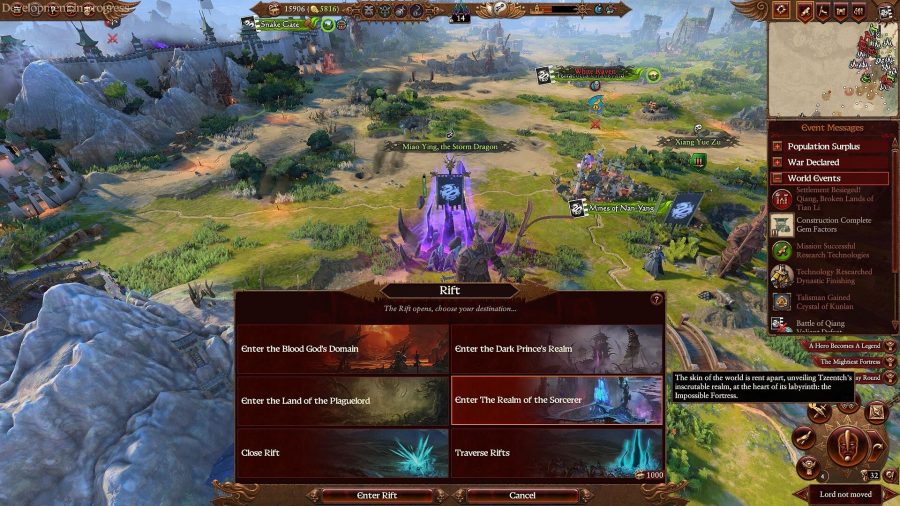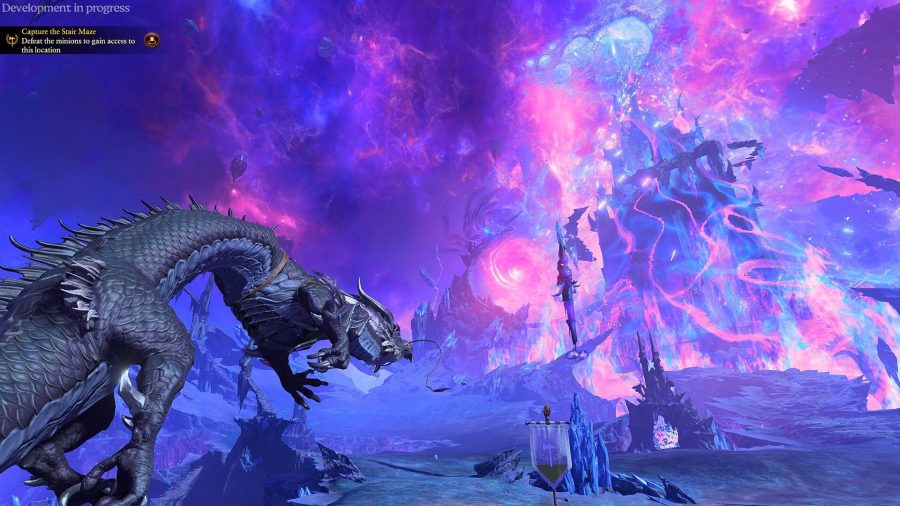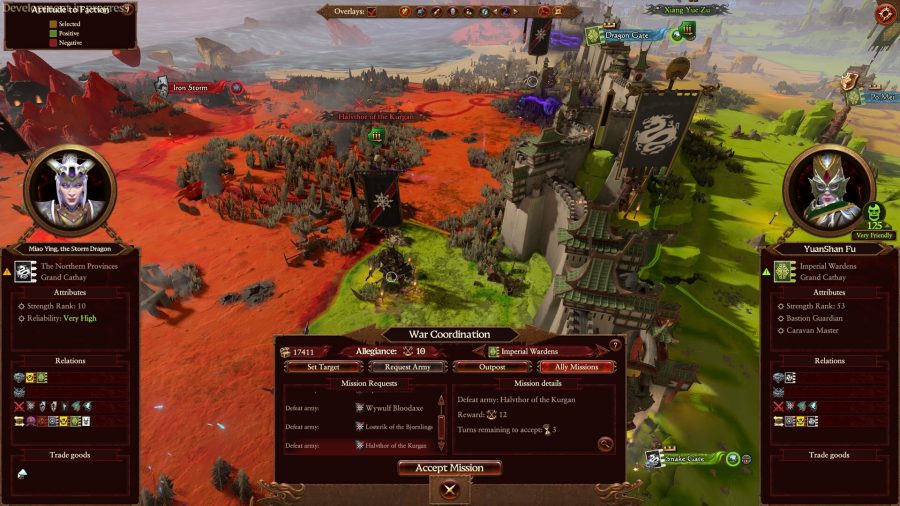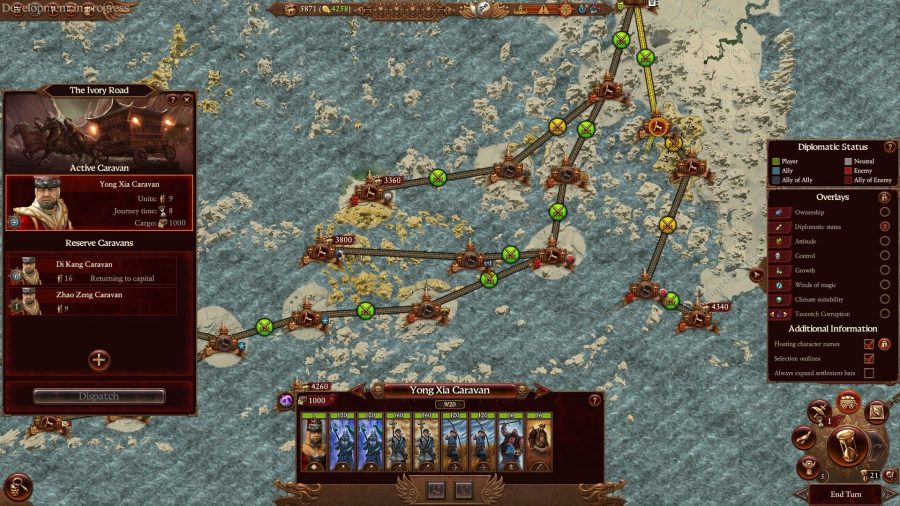I wouldn’t say it’s the best feeling, to watch a dozen portals to hell burst into existence across the green pastures of Grand Cathay, the site of my steadily growing empire in Total War: Warhammer III.
Not that it’s supposed to be, but I’m especially sensitive to this sort of thing. I like to build and beautify; I’ve been known to build unnecessary parade grounds in Command & Conquer rather than finish missions just because I thought them thematic. My biggest gripe with Total War: Warhammer II was that it would drop hostile armies into my territory as soon as I started a Vortex ritual; they always seemed to appear whenever my own troops were absent, so that no matter how I prepared, I was powerless to prevent the destruction of several carefully tended cities.
So you can imagine how I felt when these rifts into the Realm of Chaos burst upon my territory like acne before a first date. Warhammer’s infamously grimdark lore is all about the fact that even the most redoubtable city is only a Skaven orgy away from drowning in a tide of rats, but look, it’s not just me: “It felt a bit contrived that you can’t control the fact there’s going to be a few stacks coming in and attacking you,” game director Ian Roxburgh tells us, reflecting on player feedback from Warhammer II.
And as it turns out, the rifts are fine. Or at least manageable. You get a warning when they’re about to appear, and when they do, they don’t do anything too nasty – just spew out corruption in the flavour of a particular Chaos god. Leave them alone for a few turns, though, and they’ll spawn a hostile hero. A few turns more, and you get a hostile army of moderate strength. I haven’t left any open for longer than that.
Those first armies are pretty tough to deal with if you’re still in the early stages of the game, as I can attest because I was limited to 50 turns with Total War: Warhammer III’s campaign in our hands-on preview. Knowing what I was up against, I save-scummed to a few turns before the rifts appeared to see if I could prepare for their arrival more effectively than the Vortex’s invaders. Rifts can be closed by hero actions or by a lord – the lord will have to fight a battle, but the opposition is weak and the rift will close even if you lose, as I discovered by hiring and sacrificing solo lords solely for this purpose. On my second ‘rifting’, only two portals last long enough to spawn a hero, and none to throw an army at me.
“We give the player all the tools to deal with it,” Roxburgh says, and in my experience so far, that’s true. It’ll still feel like an appropriately stressful event; you’ve got to pull your heroes and lords back into your territory, deploy them efficiently, and manage the intense corruption the rifts leave behind. If you’re distracted, the consequences will quickly escalate to nation-crushing heights. But you can “strategise your way out of it,” as Roxburgh says.
A door goes both ways, and rifts are your means of ingress to the Realm of Chaos, which is basically Warhammer’s version of hell. We’ve known for a while that the ostensibly suicidal idea of entering this realm is central to Warhammer III’s plot; we fought beneath the Brass Citadel, the home turf of the Blood God Khorne, in last year’s battle preview. Now we know the reason we’re doing so; prepare for a lot of proper nouns.
Ursun, the bear god of Kislev, has been imprisoned in the Forge of Souls at the heart of the Realm of Chaos. His jailer is Be’lakor, the first Daemon Prince, who holds the dubious distinction of being hated by pretty much everyone in Warhammer lore – even the monstrous Chaos Gods themselves.
This universal hatred means Be’lakor “can do stuff that will affect everyone, and everyone’s gonna try and stop him,” principal writer Andy Hall explains, “and he’s an important character and a fan favourite, so we knew early on that we wanted to use Be’lakor in that role [as the game’s archvillain].”
For a god to be left in such a vulnerable state is an opportunity for everyone. It’s a safe assumption that Kislev will want to rescue their patron deity, while Cathay’s intro cinematic reveals that they’re out to do the same thing because Ursun can help them find Shen-Zoo, the missing younger sister of Cathay’s ruling dragon family. I was ready to assume that the Chaos gods just want to eat Ursun or something and absorb its power, but based on everything we’ve seen so far I dare to hope that each faction’s storyline may be far more intricate and particular than that.

The arch-schemer Be’lakor is certainly up to nothing so obvious. Hall teases that his “actual plan is revealed” as you complete more challenges within the Realm of Chaos. You need the soul of a Daemon Prince from each of the four gods’ domains in order to access the Forge of Souls and face Be’lakor in the campaign’s final battle, and so, as my heroes and sacrificial lords rush to close every other rift, I send Miao Ying into the one nearest my capital.
Total Warhammer’s enigmatic adviser introduces me to Tzeentch’s realm, and the Impossible Fortress at its heart. This is my destination: the Librarian, Tzeentch’s favoured Daemon Prince, is hiding there with the soul I need. Each of the four gods’ domains in the Realm of Chaos contains its own challenge – Khorne’s is a gauntlet of combat challenges, for instance, while Tzeentch’s realm is a maze, formed of floating chunks of rock.
It’s navigated by means of paired teleportation portals, but there’s no way to tell where any portal will lead until I go through it. At first I think it’s a memory test, like the card game Concentration, but then I discover that going back through a used portal doesn’t return me to the one I first entered – fitting, as one of Tzeentch’s titles is ‘Changer of the Ways’.
Defeating roaming Tzeentchian armies (each so weak that they barely dent my own, even when auto-resolving) gives me the option to mark portals with a pair of coloured glyphs. This ‘fixes’ their connection, so the challenge is to kill enough armies to either discover the path to the Impossible Fortress directly, or fix enough pairs to intuit it by process of elimination.
It’s also a race. As mentioned above, everyone has a plan for Ursun, and any of the other major powers may send their Legendary Lord into one of the four realms to claim the same prize. I’ve been hopping across these blue-tinged floating rocks for no more than a couple of turns before I’m joined in Tzeentch’s fun house by Ku’gath Plaguefather and then Skarbrand. If either of them wins the battle at the Impossible Fortress before me, I leave with nothing.
I deduce the correct portal just in time to realise Skarbrand is too close for me to catch, and get a sinking feeling as the roaming armies feed themselves to him. Surely their sacrifice will help him figure it out if he hasn’t already? But no – he stomps off in the wrong direction and, with Ku’gath hot on my heels, I’m first to the big battle.
Where the Brass Citadel had a nice sequential feel to it, the Impossible Fortress’s map is a disorienting maze of rocky outcrops on mixed elevations. The battle is tough and I scrape through by the skin of my teeth having spent most of it drowning in pink and blue flames, but I reflect that Tzeentch’s limited unit roster means that I could’ve anticipated this and built an army accordingly. Lesson learned for next time.
As my time with the build elapses and I have time to digest it all, I’m also struck by the absurdity of Warhammer III. I mean, playing Concentration with teleportation portals, chased by an incarnate fart in a floating throne? Who would’ve thought that Total War would ever take us here? It’s amazing fun so far, in case that wasn’t clear, but 50 turns is only a sliver of the full game. Total War: Warhammer 3 is out on February 17th, by which time we’ll have our final review ready for you.
